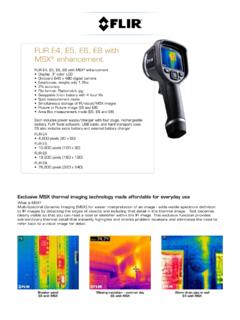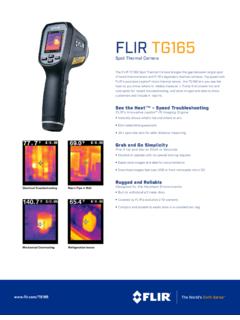Transcription of THERMAL IMAGING GUIDEBOOK FOR BUILDING AND …
1 An informative guide for the use of THERMAL IMAGING cameras for inspecting buildings, solar panels and IMAGING GUIDEBOOK FOR BUILDING AND RENEwABLE ENERGy APPLICATIONS 1 Content1. The THERMAL IMAGING camera and how it works 8 2. Why use THERMAL IMAGING ? 10 3. Using THERMAL IMAGING for BUILDING applications 14 4. THERMAL physics for BUILDING applications 26 5. THERMAL IMAGING cameras for inspecting solar panels 326 Inspecting wind turbines with THERMAL IMAGING cameras 447. choosing the right THERMAL IMAGING camera supplier 48 8. Finding the best solution 50 9. How to carry out THERMAL inspections 62 This booklet is produced in close cooperation with the Infrared Training Center (ITC).
2 All images used are for illustrative purposes only. SPECIFICATIONS ARE SUBJECT TO CHANGE WITHOUT NOTICE Copyright 2011, FLIR Systems AB. All other brand and product names are trademarks of their respective owners. 3 IntroductionThe first commercial THERMAL IMAGING camera was sold in 1965 for high voltage power line inspections, by what would later become FLIR Systems. Since then THERMAL IMAGING technology has evolved. THERMAL IMAGING cameras have become compact systems that look just like a digital video camera or digital photo camera. They are easy to use and generate crisp real-time high-resolution of the sectors that rapidly discovered that THERMAL IMAGING can provide valuable information that is practically impossible to capture with any other tool is the BUILDING industry.
3 From an exotic technology, THERMAL IMAGING cameras have evolved to a widespread tool that is used by numerous BUILDING inspectors THERMAL IMAGING camera is a unique tool to map the energy loss from a BUILDING . This method is quick and the THERMAL images which the camera produces provide a precise and convincing argumentation. The use of a THERMAL IMAGING camera either as a standalone tool or in combination with other methods such as BlowerDoor systems speeds up the work considerably. THERMAL IMAGING pinpoints exactly where the energy losses are without the use of any destructive testing methods.
4 4 THERMAL IMAGING cameras have strongly evolved over the last 50 years. FLIR Systems has always been a THERMAL IMAGING pioneer that brings the most advanced THERMAL IMAGING cameras to the THERMAL IMAGING camera is a reliable non contact instrument which is able to scan and visualize the temperature distribution of entire surfaces quickly and accurately. Thermography programs have contributed to substantial cost savings around the IMAGING for the BUILDING industrySince the 1970s we have become increasingly conscious that energy resources are precious and BUILDING sector accounts for 40% of the EU s energy requirements and offers the largest single potential for energy efficiency.
5 Due to the huge potential the European Commission has formed a directive for energy performance regulation of buildings on which many national laws are already based. Thousands of European businesses are already affected while the Energy Performance Certificates (EPCs) have become mandatory in many countries in the EU for new buildings and BUILDING refurbishments. This, together with recent economic stimulus packages in many countries, is likely to drive up the demand for air tightness testing and other methods for energy efficiency investigation. In a longer perspective we are likely to see harsher EU directives for energy savings in buildings.
6 This will have great impact on many professionals working in the BUILDING sector. 45 Modern THERMAL IMAGING cameras are small, lightweight and easy to energiesThe fact that traditional energy sources like coal, gas and oil are scarce has also led to rising prices. Furthermore, awareness has risen that we cannot keep polluting our planet using these fossil fuels. SolarSolar panels can convert the sun s energy into electricity. And into hard cash. To receive maximum returns and high yields for decades however, high quality is key. The solar module, the most important part of a solar system, must be reliable and able to continue producing electricity for years at an end.
7 To ensure good quality during the full lifetime cycle of a solar module, THERMAL IMAGING cameras can play an important use of THERMAL IMAGING cameras for solar panel evaluation offers several advantages. Anomalies can clearly be seen on a crisp THERMAL image and - unlike most other methods - THERMAL cameras can be used to scan installed solar panels during normal fossil fuel reserves dwindle, the prices for coal and gas rise to new heights and many people look to the sun for a renewable power source. But solar panels are susceptible to wear. BUILDING professionals all over the world therefore use THERMAL IMAGING cameras to inspect solar panels installed on rooftops or in solar renewable energy source is wind .
8 All over the world, windmills are becoming increasingly popular for generating electricity. Entire wind parks are being installed both on land and off windmill contains a lot of mechanical and electrical components that can easily be checked with a THERMAL IMAGING camera. Correct maintenance inspections of all parts of a windmill ensure that they will keep generating electricity for many years to come. A THERMAL image of a wind turbine taken from ground levelThis booklet is an in-depth guide for BUILDING , solar panel and windmill inspections using a THERMAL IMAGING camera. There are many details to pay attention to when carrying out a THERMAL inspection.
9 As well as knowing how the THERMAL camera works and how to take images, it is important to know the physics behind the THERMAL patterns of a BUILDING , solar panel or windmill, and how they are constructed. All of this has to be taken into consideration to understand, interpret and judge THERMAL images correctly. It is impossible, however, to cover all principles, concepts and use of systems for analysis of these types of applications in this GUIDEBOOK . That is why FLIR Systems offers training courses in cooperation with the Infrared Training Center (ITC) specifically designed for BUILDING applications.
10 This GUIDEBOOK will present THERMAL IMAGING applications How the THERMAL IMAGING camera works and what to consider when purchasing a camera Comprehensive advice on how to conduct thermographic surveys67 The THERMAL IMAGING cameraand how it worksA THERMAL IMAGING camera records the intensity of radiation in the infrared part of the electromagnetic spectrum and converts it to a visible image. What is infrared?Our eyes are detectors that are designed to detect electromagnetic radiation in the visible light spectrum. All other forms of electromagnetic radiation, such as infrared, are invisible to the human eye.










